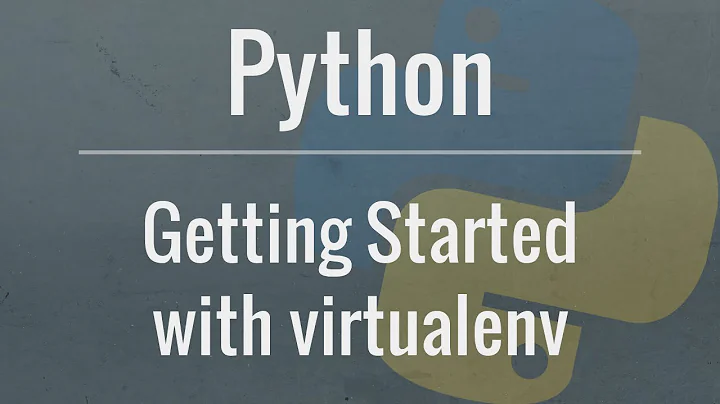pyvenv vs venv vs python-virtualenv vs virtualenv and python 3
The way to install Python 3.x packages in a Python virtual environment is to create the Python virtual environment using Python 3 virtual environment creator (python3-virtualenv). python3-virtualenv is in the default Ubuntu repositories in Ubuntu 14.10 and later.
Install Python 3.x packages in a Python virtual environment in 16.04 and later
Install Python 3 virtual environment creator
sudo apt install virtualenv python3-virtualenvCreate a Python virtual environment for python3. You can only install python3 packages inside this Python virtual environment. If you also want to install Python 2.x packages, then you need to make another Python virtual environment.
virtualenv -p python3 venv source ./venv/bin/activateThe new Python virtual environment for python3 will be created in the
venvdirectory which is located in the current directory.Install Python packages.
cd /path/to/venv/ # venv is the python3 virtual environment's directory source bin/activate python3 -m pip install first-package-name next-package-name last-package-name
This is a new python3 virtual environment with the latest version of pip3, so installing Python packages in it will work great.
Install Python 3.x packages in a Python virtual environment in Ubuntu 14.04
sudo apt-get install virtualenvwrapper
gedit .bashrc
Add the following line to the end of .bashrc.
source /usr/share/virtualenvwrapper/virtualenvwrapper.sh
Save the changes to .bashrc and close gedit. Source your .bashrc for the changes to take effect.
cd
source .bashrc
Create a Python virtual environment for python3. You can only install python3 packages inside this Python virtual environment. If you also want to install Python 2.x packages, then you need to make another Python virtual environment.
mkvirtualenv py3 -p /usr/bin/python3
The new Python virtual environment for python3 will be created in the ~/.virtualenvs/py3 directory. .virtualenvs is a hidden folder.
Install a package.
cd ~/.virtualenvs/py3 source bin/activate python2 -m pip install package-name
Related videos on Youtube
Malik A. Rumi
Updated on September 18, 2022Comments
-
Malik A. Rumi over 1 year
malikarumi@Tetouan2:~$ pip install virtualenv Collecting virtualenv Downloading virtualenv-12.0.7-py2.py3-none-any.whl (1.8MB) 100% |################################| 1.8MB 330kB/s malikarumi@Tetouan2:~$ pip freeze (a lot of stuff, but not virtualenv) malikarumi@Tetouan2:~$ virtualenv testvenv1 The program 'virtualenv' is currently not installed. You can install it by typing: sudo apt-get install python-virtualenvWhat is going on here? is python-virtualenv == pyvenv? Isn't that still broken? Does original virtualenv still work with python? if venv (too many name variations!!!) is part of the standard library, https://docs.python.org/3/library/venv.html, why am I being told to install it?
And when I did try to install it, I got:
malikarumi@Tetouan2:~$ sudo apt-get install python-virtualenv Reading package lists... Done Building dependency tree Reading state information... Done The following extra packages will be installed: python-colorama python-distlib python-html5lib python-pip python-setuptoolsAt which point I aborted, because installing python3-pip just before that had given me
Setting up python3-setuptools (3.3-1ubuntu1) ... Setting up python3-pip (1.5.4-1) ...And I wasn't sure if the extra packages would overwrite them or go onto python 2.7.
I read that python 3 is supposed to be the default going forward. Since both 2.7 and 3.4 are there, and have separate commands, how do I not only make sure Python 3 is my default, but that anything I install goes there and is used by it instead of 2.7?
BTW, I tried sudo apt-get python3-virtualenv and got: E: Unable to locate package python3-virtualenv
-
Malik A. Rumi about 9 yearsI'd still like to know what the difference - if any - is between all these different but similarly named virtual environment packages.
-
FriendFX over 7 yearsI'm using 14.04, so this answer helped me.
-
-
knite almost 9 yearsThis doesn't seem to be correct. Vivid (15.04) has
python3-virtualenvandpython3-venvpackages available. I'm assumingpython3-venvis the correct package, in which case I have no idea what purposepython3-virtualenvserves. -
saaj about 7 yearsIncorrect. You can use
virtualenv(executable) to create environment with arbitrary interpreter, including PyPy, just fine E.g.virtualenv -p python3 newenv. -
 karel about 7 yearsI have also noticed the same thing on my machine which was running Ubuntu 14.04 at the time. - "As you can see even though virtualenv package is using python3-virtualenv, its default is to create Python 2 environment."
karel about 7 yearsI have also noticed the same thing on my machine which was running Ubuntu 14.04 at the time. - "As you can see even though virtualenv package is using python3-virtualenv, its default is to create Python 2 environment." -
reducing activity over 2 yearsWhat is the relation between
python3-venvandpython3-virtualenv? The first one is recommended by Ubuntu (Command 'pyvenv' not found, but can be installed with) but installing it fails to change anything. -
 karel over 2 years@reducingactivity First run the command
karel over 2 years@reducingactivity First run the commandapt show python3-venv python3-virtualenvand leave the terminal open for reference. Then read the accepted answer to What is the difference between venv, pyvenv, pyenv, virtualenv, virtualenvwrapper, pipenv, etc?.






